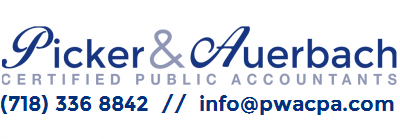
Barry Picker has a clear idea about what workflow products are supposed to accomplish in his firm’s tax office. “The goal is to do as little possible with the keyboard when you are working with a tax return,” says Picker, a partner in a nine-person firm Picker and Auerbach, CPAs based in Brooklyn, N.Y.
That hasn’t been the way the firm operated. It had scanned source documents. But from there, the return bounced around the office, which is what using 1040 Scan from SurePrep is designed to change.
“I will do initial review when it comes back-give it to somebody else to do a mathematical review-that is somebody will add the 1099s and compare to the returns,” Picker explains. “We are trying to change that going forward.”
The main thing that we wanted was the Schedule D input. We have clients that have a lot of transactions,” says Picker. “Anything that would make that part of the data entry easier was something to look forward to.”
Picker’s firm began using 1040 Scan on 2006 extension returns and then used it on 200 individual returns for the 2007 tax year. Next year, Picker plans to extend that to fiduciary returns.
It’s a fairly simple change, but far reaching, on the individual returns.
“When we do the personal tax return, we don’t have to print the W-2 just to scan it back in,” says Picker. “If we can get an Excel spreadsheet on gains and losses, we can input that into Lacerte without having to scan a brokerage statement in.”
The importance that workflow has assumed in the tax and accounting market was shown by the fact that Mike Sabbatis, CEO of CCH, made a presentation about workflow at the Sept. 25 Investor’s Day of CCH’s parent company, Wolters Kluwer.
Sabbatis says CCH studies how tax professionals work in designing its tools.
That meant looking at “What do they do a couple of minutes before they use our product and a couple of minutes after they use our product, they start to put the tax file together,” he says.
And while CCH doesn’t market its own workflow product because it partners with XCM Solutions, such applications have become an important enough part of the business that it has a workflow division, headed by sales manager James Koch.
“A few years ago, when we went out and talked about workflow, there was a lot of talk about ‘What is workflow?’ Now it’s a central part of most presentations we do,” says Koch. “There are very few tools that an accounting firm can buy today that can have the same impact.”
Ironically, two major workflow applications were designed as a fall-back position. They come from companies that were pushing overseas outsourced preparation of tax returns. When outsourcing stalled, the two pioneers, SurePrep and Xpitax, developed workflow applications.
That relationship, and the impact of workflow, is shown by the experience of New York-based Fuoco Group, according to director Joe Manzelli Jr.
The company began using XCM, the workflow product from XCM Solutions of Braintree, Mass., two years ago.
“Their workflow was designed for outsourcing,” notes Manzelli. But what adoption of the XCM workflow software enabled the firm to do was save enough time that it no longer needed the outsourcing services.
For the 2006 tax year, the firm outsourced 450 to 500 returns, but only 50 for 2007. No returns will be outsourced during the next season. While Manzelli says he can’t categorize the amount of time saved by use of XCM, it can be viewed in terms of the elimination of outsourcing.
Fuoco is going beyond workflow as simply a tool used in tax preparation.
“We started using it to track everything we do tax returns, write-up, sales tax returns,” says Manzelli. With the advent of version 6.0, he continues, “it’s going to be able to help track the workflow not just in tax preparation, but in bookkeeping and financial statement preparation. We have looked at trying to keep track of an audit or a review.”
With XCM version 6.0, users can set up recurring tasks, such as the need to process sales taxes or payroll taxes. The product is priced at $50 per user, $3 per client.
“You tell it [the application] when you want to be notified,” says Manzelli. The system can be set up to notify him to review a return or to send it to a preparer. He continues, “You almost don’t have to think about what you want to do.”
The system will automatically send an email to the person who is supposed to perform a specific task, such as prepare a return for a certain client.
It has helped us with our paperless initiative as well,” he says. “You don’t have to put paper in front of people.”
Source documents are not only scanned in, but the system creates a link so that the preparer not only knows which return to work on, but is presented with the link to the proper source documents.
It also lets employees work remotely.
“I don’t have to be in the office-with the email notification-especially during tax season, I can know the night before I have seven returns to review-I don’t have to look at anything on my desk,” he says.
CCH’s Koch likes the ability to tailor XCM to the different ways that firms do businesses.
“I once thought a 1040 was a 1040 and an 1120 was an 1120, and if I sent one to one firm, they must do them the same way as other firms. Nothing could be further from the truth,” he says. One of the important features of XCM is the ability to set up different workflows for the different ways that firms do business.
Glen Keenan, president of XCM, says that in XCM 6.0, recently introduced, his company stuck to its philosophy of providing pre-built workflows to fit the different needs of partners.
“The managing partner needs different things than the tax and audit partner. The managing partner wants to know what utilization levels are, what staffing looks like in order to be profitable,” says Keenan. “From the tax partner and audit partner standpoint, they care about those things, but their primary concern is ‘How do I serve my clients best?'”
Other features in 6.0 include audit and accounting-specific compliance tools, along with what the company says is more robust due-date monitoring features featuring customizable, firm-specific jurisdictions.
Extract and Populate
Most of the workflow applications give accountants the ability to scan documents and produce a bookmarked PDF. Currently, only one claims the ability to extract the document from the source documents and populates a tax return.
That’s going to change quickly as both CCH and GruntWorx are introducing products with those capabilities. But for the moment David Wyle, CEO of SurePrep, says it’s an ability that sets his company’s products apart. Wyle also claims SurePrep products have a big advantage in the number of source documents they recognize because of the software’s ability to learn to recognize new ones.
“We are enhancing logic and features so the system can figure out what data is on a document, what data should go on the return and what shouldn’t,” he says. SurePrep software is “smart enough” to recognize documents. He says that “No other packages populate returns right now,” and adds that “They don’t recognize any K1s or any brokerage statements.”
One thing that SurePrep added last season is the ability to deal with files that in whole or part are not recognized by the optical character recognition process. The scanning products now automate file organization by bookmarking and filing the documents that are recognized by the system. Papers that aren’t recognized go to the bottom of the pile.
1040 Scan, which has a list price of $30 per return, will also identify appropriate tax treatment for foreign income, identifying and entering the Foreign Gross Income in brokerage statements. It spots dependent source documents and determines if income should be included on a parent’s return. And it can identify generic source documents, such as 1099-MIS and assign them to related parent schedules, based on pro forma data.
SurePrep also offers 1040 Scan Lite, which Wyle says is to scan and organize system that more closely resembles the approach of other products on the market. “It doesn’t read data from the document and export it to the return,” he says. “But it’s less than half the price.”
While 1040 Scan and the Lite version are both desktop-based systems, the SurePrep Express and companion SurePrep Express Lite are Web-based systems. SurePrep Express categorizes source documents as standard if they have common line or box numbers, such as W-2 or 1099, and as complex if they do not.
Copanion, which produces the GruntWorx line, has also been busy with product-line changes. The initial product, GruntWorx is another scan and organize product, which does not put the data in the tax return, and is priced at roughly $1 per return processed. The approach has changed with the introduction of GruntWorx Pro, which provides data extraction and population capabilities, but with a difference. In fact, accountants are telling Copanion that they don’t want to have a product that automatically extracts data and populates the return, according to CEO Stephen Ladd.
“The accountants are saying they want control. They say, ‘I don’t want data to go into my tax return,'” says Ladd. “Instead of putting the data in the tax return, we put it in an intermediate place where they can control it.”
The company also chose ease of use over sophisticated technology in designing products.
“If we had a decision between technical perfection and ease of use, we took ease of use every time,” says Ladd.
The first release of the Web-based GruntWorx Pro will be available for Thomson’s GoSystem ES. Because both GruntWorx Pro and GoSystem ES are Web-based, the source document data is imported directly into GoSystem. The company planned to announce support for other tax preparation packages during the end of this year. The system recognizes a variety of W-2 and 1099 forms, some K-1 forms, brokerage statements and grantor letters.
Ladd has some reservations about some of the claims regarding the amount of time that workflow software can save firms
“We are seeing people saying they save from 15 to 45 minutes per return,” he says. “I buy 10 to 15 or 20 minutes.”
New Kid
Intuit has yet to play the workflow game through a tax season, but that’s about to change with the introduction of Tax eSort, a workflow tool, that’s coming to market with a client portal product that will probably be used in Tandem.
At press time, pricing had not yet been set for Tax eSort, or Intuit Document Exchange, the portal tool. But the company says both will be ready for use for preparing 2008 tax returns.
The eSort package will work with both the ProSeries and Lacerte tax preparation packages, along with the Document Management System. Like other packages on the market, eSort starts with upfront scanning and is designed for a tax-prep world that has come to rely on multiple monitors.
At the moment, the product does not extract data from scanned documents and populate returns. However, Intuit is studying the possibility of introducing such a product, although there are no plans for either an introduction or an announcement.
“That is something we are continuing to research and explore,” says Kristi Gardi, senior product manager for Intuit’s Accounting Professionals Division.
Intuit Document Exchange is not yet directly related to the workflow applications. But it is related in the sense that both are designed to reduce paper handling in the tax and accounting office, says product manager Kathy Kirkendall.
“You may call it a client portal. It provides a secure online location for all client files and documents,” she says. “At any point during tax season, if the accountant wants a snapshot of any activity in his portal for all of his client base, he can view all clients that have posted files.”
Preparers will have the expected ability to post client documents on the portals and they will also have the ability to view all posted files provided to the client or provided by the client.
Kirkendall believes that the use of private client portals will save each partner about 5 to 10 hours per client per tax season, primarily because they will be able to find documents easily. They will also be able to design the landing page that provides the interface to posted documents and practitioners will have PIN-based access to log into the site.
It’s an easy step to having the workflow product directly link to the portal, with notifications flowing automatically both ways. And the Intuit officials say that’s a logical direction the products will move.




